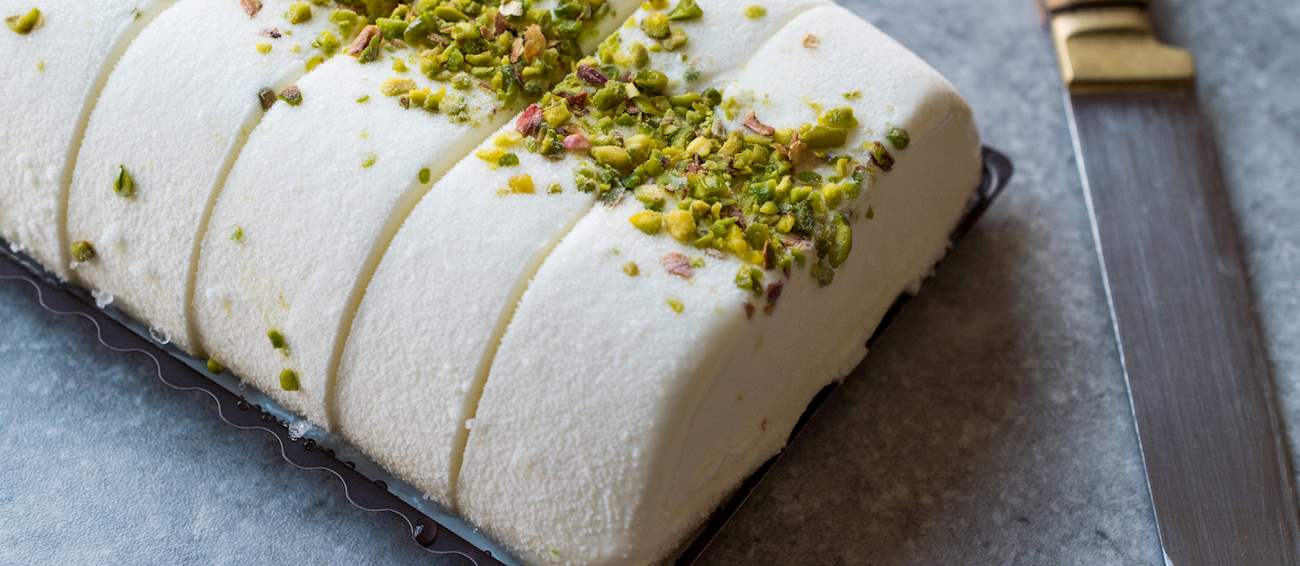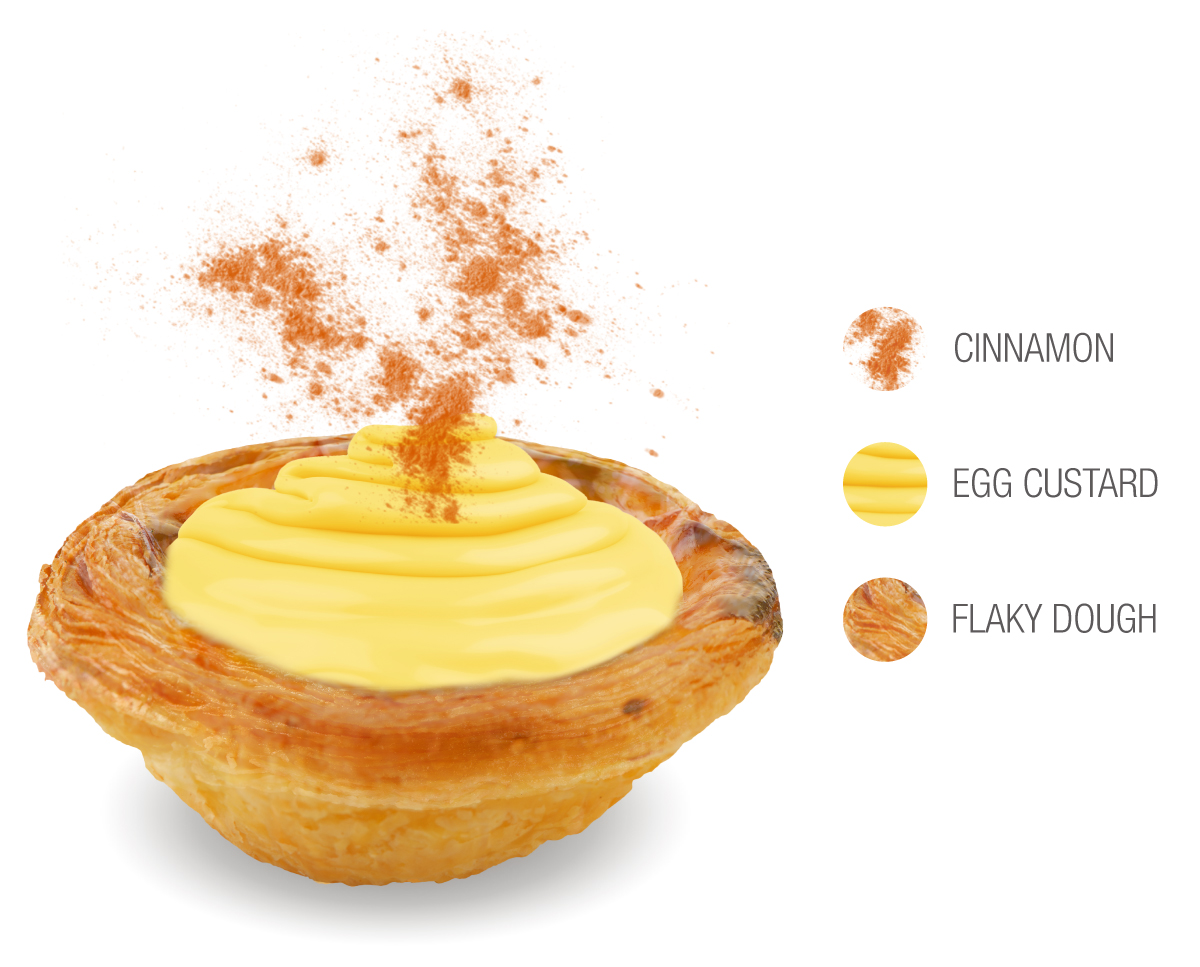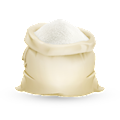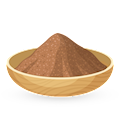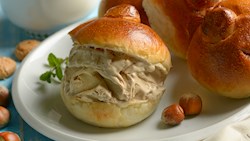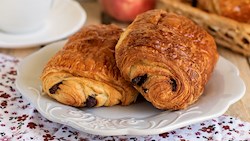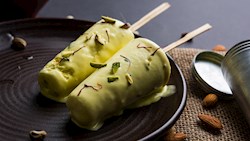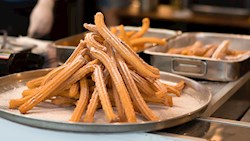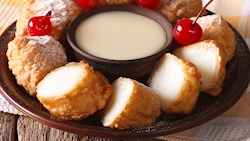Pastel de nata is a traditional egg custard tart that is popular throughout the world. It is believed that for the best result, the filling should not be too sweet and should not have flavors of lemon nor vanilla. Instead, the tarts should be sprinkled with cinnamon and, ideally, paired with a cup of coffee.
Originally, this treat was made before the 18th century by Catholic monks and nuns in Santa Maria de Belém in Lisbon. The tart was made from leftover egg yolks that were used in the clearing of wines and starching of clothes. Later on, the clerics made a deal with a nearby bakery to start selling pastel de nata commercially, and the product was a huge success.
VARIATIONS OF Pastel de nata
MOST ICONIC Pastel de nata
View moreMAIN INGREDIENTS
Turkish ice cream is believed to originate from the city of Maraş—hence the name—and what really sets it apart from other varieties is its resistance to melting and a particularly dense, chewy texture. These qualities are brought by adding two thickening agents to the basic milk and sugar mixture: Arab gum, also known as mastic resin, and salep—a type of flour made from the root of the early purple orchid.
In fact, in the Kahramanmaraş region, ice cream typically contains distinctly more salep than usual, which is why it is sometimes called kesme dondurma—from the Turkish kesmek, meaning to cut—which is the reason why this ice cream variety is usually eaten with a knife and fork.
MOST ICONIC Dondurma
View moreThese thin pancakes are made with wheat flour, and have origins in the French region of Brittany. Although they are a French staple and a national dish, crêpes are so popular that they have spread worldwide since the turn of the 20th century, when white wheat flour became affordable.
These delectable treats are made with flour, eggs, milk, and butter whipped into a thin batter, which is then poured in a crêpe pan and fried. The tradition is to flip them in the air as they cook, and they say that if you catch it in the pan, your family will be well-off for the rest of the year.
VARIATIONS OF Crêpes
MOST ICONIC Crêpes
View moreMAIN INGREDIENTS
Kunāfah consists of two crunchy layers of shredded and buttered kataifi or knefe dough, filled with a luscious cheese cream that's often flavored with orange zest and cardamom, then drenched in a sugar syrup infused with lemon juice and orange blossom water.
Turkish künefe is traditionally made with Hatay, Urfa, or Antep cheese. It is usually topped with pistachios and is best served warm. Elegant and amazingly simple to make, this dessert is nothing short of what cheese-filled pastry dreams are made of.
MOST ICONIC Kunāfah
View moreCrêpes sucrées are sweet crepes, a type of very thin pancake originating from France. The term "sucrées" means "sugared" in French, indicating that these crepes are meant to be served with sweet fillings or toppings. They are made from a simple batter consisting of flour, milk, eggs, a pinch of salt, and sometimes a bit of sugar and butter.
Unlike their savory counterpart, known as "crêpes salées" (or "galettes" in some regions of France), sweet crêpes are usually made with white wheat flour and often have a bit of sugar added to the batter. Sweet crepes can be filled or topped with a variety of ingredients such as powdered sugar, whipped cream, fruit preserves, fresh fruits, nutella, honey, and maple syrup.
VARIATIONS OF Crêpes sucrées
Pistachio is one of the most popular flavors of Italian gelato. A mainstay in every gelateria, in its original form, this frozen treat combines pistachio paste with the classic base of milk, cream, eggs, and sugar. Occasionally, crushed and toasted pistachios can be added, but the basic texture should always remain dense and creamy.
Due to the high prices of pistachios and pistachio paste, many gelaterias nowadays opt for cheaper replacements, but the best pistachio is considered to be the grown in a small Sicilian town of Bronte.
MOST ICONIC Gelato al pistacchio
View moreMAIN INGREDIENTS
Fried bananas or plantains are a common everyday snack eaten throughout Indonesia. They come in numerous versions in which the fruit is simply fried in shallow oil, but more often sliced banana pieces are coated in batter before they are fried until golden.
Besides numerous other varieties, fried bananas also appear under different names such as godoh biu on Bali or gedhang gorèng on Java. They are traditionally sold at street stalls and carts and belong to a group of gorengan dishes—Indonesian deep-fried snacks.
MAIN INGREDIENTS
Nutella crêpes is a popular variation of a sweet crêpe that is generously spread with Nutella, a hazelnut cocoa spread. This indulgent treat combines the soft, warm texture of a freshly made crêpe with the rich, creamy flavor of Nutella, making it a favorite among both children and adults.
A basic crêpe batter made with flour, eggs, milk, a pinch of salt, and sometimes a little sugar and vanilla for added sweetness is cooked on a flat griddle or in a crêpe pan to create a thin pancake. Once the crêpe is cooked to a light golden brown and is still hot, a generous amount of Nutella is spread over one-half or the entire surface of the crêpe.
Bionico is a popular Mexican street food item in the form of a fruit cocktail, originating from Guadalajara. Chopped fruits such as papaya, strawberries, cantaloupe, apples, and bananas are topped with a sweet cream mixture, granola, pecans, raisins, and desiccated coconut.
The dish was invented in the early 1990s as a healthy breakfast meal. As its popularity grew, the dessert spread throughout Mexico and even to some parts of the United States. Today, bionico is mostly served by street vendors or it can be bought at numerous juice bars and ice cream shops.
Delicious and fragrant waffles are the most famous Belgian culinary trademark. Made with thick dough or thin batter, the cakes are baked in a specially designed waffle iron which creates an unusual checkered pattern on the top and bottom of each cake.
In Belgium, there are two distinct varieties of this national dessert: the light Brussels waffle, and the denser Liege waffle. The key distinction is in the batter: while the Brussels waffle batter is thin and runny, the Liege variety is made with a thick, brioche-like dough which produces a cake with uneven edges and dense texture.
VARIATIONS OF Gaufre
MOST ICONIC Gaufre
View moreTasteAtlas food rankings are based on the ratings of the TasteAtlas audience, with a series of mechanisms that recognize real users and that ignore bot, nationalist or local patriotic ratings, and give additional value to the ratings of users that the system recognizes as knowledgeable. For the “Top 100 Street Food Sweets in the World” list until March 20, 2025, 17,976 ratings were recorded, of which 12,795 were recognized by the system as legitimate. TasteAtlas Rankings should not be seen as the final global conclusion about food. Their purpose is to promote excellent local foods, instill pride in traditional dishes, and arouse curiosity about dishes you haven’t tried.
